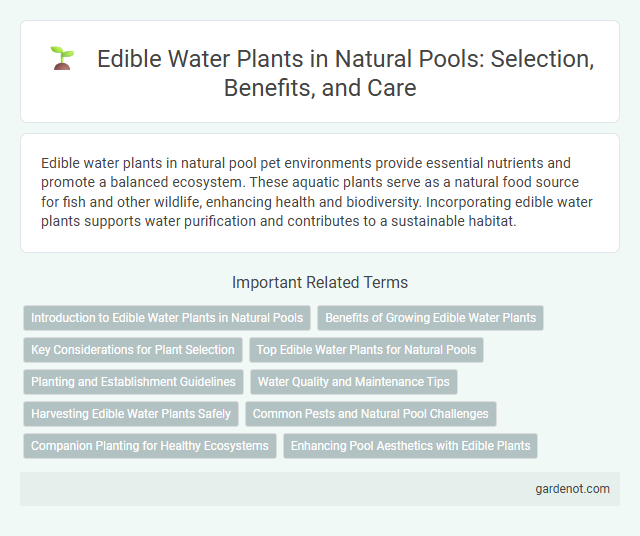Edible water plants in natural pool pet environments provide essential nutrients and promote a balanced ecosystem. These aquatic plants serve as a natural food source for fish and other wildlife, enhancing health and biodiversity. Incorporating edible water plants supports water purification and contributes to a sustainable habitat.
Introduction to Edible Water Plants in Natural Pools
Edible water plants in natural pools play a vital role in maintaining ecosystem balance while offering sustainable food sources. Species such as watercress, water spinach, and duckweed thrive in these aquatic environments, providing essential nutrients and supporting biodiversity. Integrating edible water plants enhances water quality by filtering pollutants and contributes to a resilient, self-sustaining natural pool system.
Benefits of Growing Edible Water Plants
Growing edible water plants in a natural pool enhances water quality by filtering pollutants and increasing oxygen levels, supporting a balanced aquatic ecosystem. These plants provide a sustainable source of nutritious food rich in vitamins and minerals, promoting local biodiversity and reducing reliance on external agricultural inputs. Incorporating edible water plants also aids in natural pest control, minimizing the need for chemical treatments and fostering a healthier environment.
Key Considerations for Plant Selection
Selecting edible water plants for a natural pool requires evaluating water quality parameters such as pH, nutrient levels, and light availability to ensure optimal growth and safety. It is essential to choose species known for their natural filtration capabilities and non-toxicity, like watercress or water spinach, which contribute to maintaining balanced ecosystems and provide edible yields. Plants must also be compatible with local climate conditions and resistant to pests to reduce maintenance and enhance sustainability.
Top Edible Water Plants for Natural Pools
Top edible water plants for natural pools include watercress (Nasturtium officinale), which thrives in clean, flowing water and provides a peppery flavor rich in vitamins A and C. Lotus (Nelumbo nucifera) offers edible seeds and roots, contributing to nutrient cycling while enhancing pool aesthetics with its large leaves and flowers. Water spinach (Ipomoea aquatica) grows rapidly in aquatic environments, supplying a versatile leafy green that supports natural water filtration and biodiversity.
Planting and Establishment Guidelines
Edible water plants such as watercress and water spinach thrive in natural pools with stable water quality and appropriate light conditions. Planting requires anchoring young seedlings in nutrient-rich substrate within shallow zones of 15-30 cm depth to promote root establishment and oxygenation. Regular monitoring of water temperature between 10-25degC and maintaining pH levels around 6.5-7.5 ensures optimal growth and sustainable edible biomass production.
Water Quality and Maintenance Tips
Edible water plants like watercress and duckweed play a crucial role in maintaining natural pool water quality by absorbing excess nutrients and reducing algae growth. Regularly trimming these plants prevents overgrowth, ensuring optimal oxygen levels and clear water. Maintaining balanced pH and monitoring nutrient levels further enhance the effectiveness of edible water plants in natural pool ecosystems.
Harvesting Edible Water Plants Safely
Harvesting edible water plants such as watercress, cattails, and duckweed requires careful attention to water quality to avoid contamination by pollutants or harmful bacteria. Using gloves and clean tools helps minimize damage to the plants and reduces the risk of introducing pathogens. Ensuring plants are harvested from natural pools with clear, unpolluted water supports safe consumption and preserves the aquatic ecosystem.
Common Pests and Natural Pool Challenges
Edible water plants in natural pools often attract common pests such as aphids, snails, and water beetles, which can damage leaves and roots. These pests challenge natural pool maintenance by disrupting plant health and water quality, requiring organic pest control methods like introducing natural predators or using neem oil. Balancing edible plant growth with pest management is crucial to sustaining a healthy, chemical-free ecosystem in natural pools.
Companion Planting for Healthy Ecosystems
Edible water plants like watercress and duckweed improve natural pool ecosystems by enhancing water quality and providing habitat for beneficial microorganisms. Incorporating these companion plants supports nutrient cycling and controls algae growth, promoting balanced aquatic environments. Their presence encourages biodiversity, which stabilizes natural pool health and reduces maintenance needs.
Enhancing Pool Aesthetics with Edible Plants
Incorporating edible water plants like watercress and water spinach into natural pools enhances visual appeal while promoting ecological balance. These aquatic plants help maintain water clarity by absorbing excess nutrients, reducing algae growth naturally. Their lush greenery and edible qualities provide both aesthetic charm and sustainable benefits to eco-friendly pool designs.
Edible water plant Infographic

 gardenot.com
gardenot.com